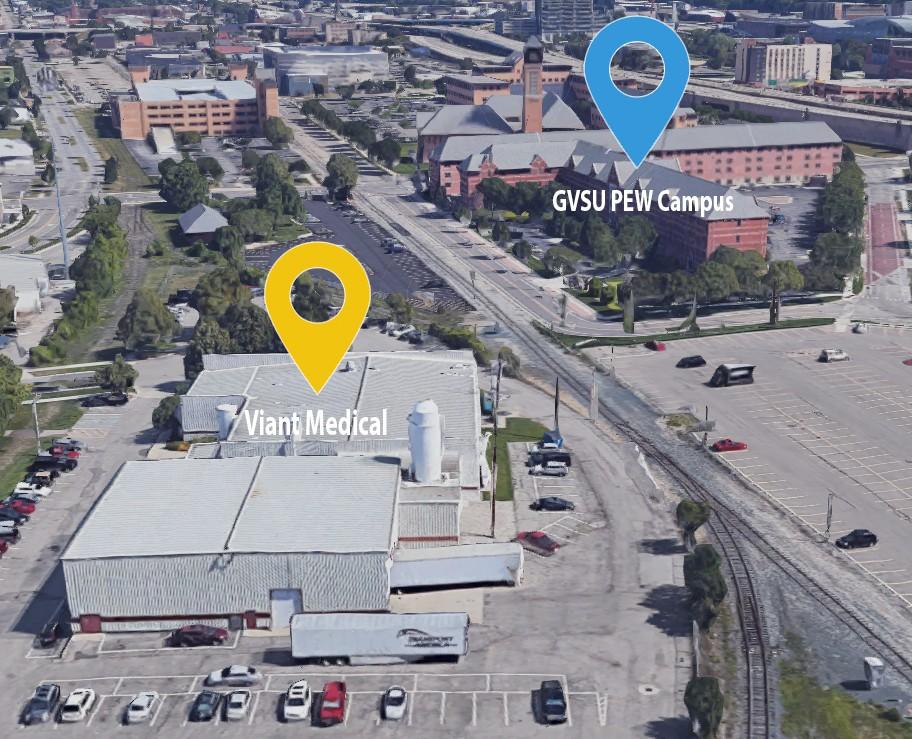Increased ethylene oxide emissions surround Pew Campus

Courtesy / Google Maps
Jan 28, 2019
Viant Medical Inc. of Grand Rapids is currently facing scrutiny from the Michigan Department of Environmental Quality (DEQ) after the company violated ethylene oxide emission levels. Located at 520 Watson St., the company stands less than half of a mile away from Grand Valley State University’s downtown Pew Campus.
On Friday, Jan. 18, all GVSU students received an email from university officials warning them of the increased level of ethylene oxide.
According to information presented by the Occupational Safety and Health Administration (OSHA) of the U.S. Department of Labor, exposure to the gas may cause numerous health problems, which include respiratory problems, dizziness, nausea and headaches. Moreover, the OSHA classifies ethylene oxide as a known carcinogen and cites studies linking it to cases of leukemia and other forms of cancer.
This was not Viant’s first violation of emission levels; according to a report from MLive, the company had multiple previous violations. In July 2018, DEQ personnel cited the facility with the “failure to adequately capture and control ethylene oxide emissions.”
After additional air samples were tested in fall of 2018 during a return inspection, the DEQ found that emissions from the facility exceeded the Environmental Protection Agency’s (EPA) acceptable limit of ethylene oxide by 150 times.
Despite this increase in emissions, Supervisor of Michigan’s Department of Environmental Quality’s Air Quality Division Robert Sills told GVSU authorities that there is little cause for concern.
“Our evaluation has found no reason to be concerned about short-term health effects at the level of emissions and exposure we think are occurring,” Sills said in a statement to GVSU authorities, which was released to students through email. “Our concern is only for long-term exposure.”
First-year student Rachael Les said that she has heard others complain about the air quality in the downtown area.
“I haven’t personally noticed a difference in air quality, but I have heard from many other students that there’s a noticeable difference,” Les said.
Since the passage of the Clean Air Act in 1970, the EPA has been charged with setting National Ambient Air Quality Standards to decrease hazardous pollutants in the country. Through the decades, these standards have significantly lowered national concentrations of several pollutants, including sulfur dioxide, lead and carbon monoxide.
The EPA states on their website that “the U.S. leads the world in having clean air and a strong economy due to the implementation of the Clean Air Act.”
However, some metropolitan areas still continue to struggle with air pollution. Topping the list of the American Lung Association’s 2018 State of the Air Report for the most polluted cities include Los Angeles and Fairbanks, Ark. Grand Rapids is tied for the 34th most polluted city in the U.S.
Les thinks the local community could take away a few lessons from Viant’s violation of ethylene oxide emissions.
“Pollution is a more commonly occurring issue in our world, and… it doesn’t only affect places far from home,” Les said. “We should take this experience and maybe learn ways to deal with air pollution in times when it’s more serious.”
On Jan. 25, Viant Medical Inc. spokesperson John Truscott stated that Viant is aware of the health concerns and aims to address them.
“We understand the concerns of those in the community and are committed to ensuring our facility follows state and federal standards in support of public health,” Truscott said. “The public’s safety is of utmost concern, and we will continue to work closely with the DEQ to ensure proper measures are in place and the public receives accurate information.”
Viant Medical Inc. did not return Lanthorn’s request for information regarding how the company plans to change their practices to reduce emissions in the future in order to comply with the EPA.





















